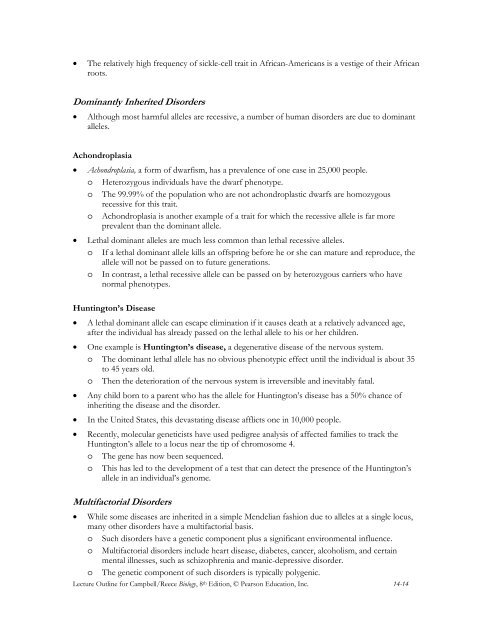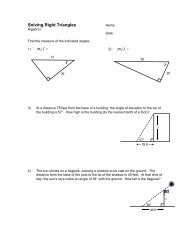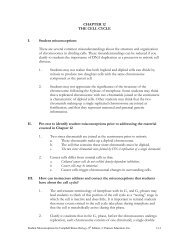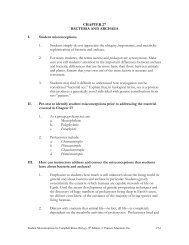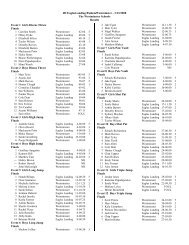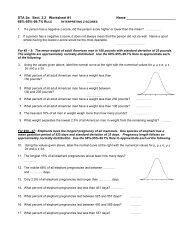CHAPTER 14 MENDEL AND THE GENE IDEA - Hancock High School
CHAPTER 14 MENDEL AND THE GENE IDEA - Hancock High School
CHAPTER 14 MENDEL AND THE GENE IDEA - Hancock High School
You also want an ePaper? Increase the reach of your titles
YUMPU automatically turns print PDFs into web optimized ePapers that Google loves.
The relatively high frequency of sickle-cell trait in African-Americans is a vestige of their African<br />
roots.<br />
Dominantly Inherited Disorders<br />
Although most harmful alleles are recessive, a number of human disorders are due to dominant<br />
alleles.<br />
Achondroplasia<br />
Achondroplasia, a form of dwarfism, has a prevalence of one case in 25,000 people.<br />
o Heterozygous individuals have the dwarf phenotype.<br />
o The 99.99% of the population who are not achondroplastic dwarfs are homozygous<br />
recessive for this trait.<br />
o Achondroplasia is another example of a trait for which the recessive allele is far more<br />
prevalent than the dominant allele.<br />
Lethal dominant alleles are much less common than lethal recessive alleles.<br />
o If a lethal dominant allele kills an offspring before he or she can mature and reproduce, the<br />
allele will not be passed on to future generations.<br />
o In contrast, a lethal recessive allele can be passed on by heterozygous carriers who have<br />
normal phenotypes.<br />
Huntington’s Disease<br />
A lethal dominant allele can escape elimination if it causes death at a relatively advanced age,<br />
after the individual has already passed on the lethal allele to his or her children.<br />
One example is Huntington’s disease, a degenerative disease of the nervous system.<br />
o The dominant lethal allele has no obvious phenotypic effect until the individual is about 35<br />
to 45 years old.<br />
o Then the deterioration of the nervous system is irreversible and inevitably fatal.<br />
Any child born to a parent who has the allele for Huntington’s disease has a 50% chance of<br />
inheriting the disease and the disorder.<br />
In the United States, this devastating disease afflicts one in 10,000 people.<br />
Recently, molecular geneticists have used pedigree analysis of affected families to track the<br />
Huntington’s allele to a locus near the tip of chromosome 4.<br />
o The gene has now been sequenced.<br />
o This has led to the development of a test that can detect the presence of the Huntington’s<br />
allele in an individual’s genome.<br />
Multifactorial Disorders<br />
While some diseases are inherited in a simple Mendelian fashion due to alleles at a single locus,<br />
many other disorders have a multifactorial basis.<br />
o Such disorders have a genetic component plus a significant environmental influence.<br />
o Multifactorial disorders include heart disease, diabetes, cancer, alcoholism, and certain<br />
mental illnesses, such as schizophrenia and manic-depressive disorder.<br />
o The genetic component of such disorders is typically polygenic.<br />
Lecture Outline for Campbell/Reece Biology, 8 th Edition, © Pearson Education, Inc. <strong>14</strong>-<strong>14</strong>


